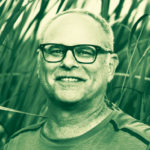OBSERVATIONS Joseph Noel Learning from lagoons
Professor Joseph Noel, director of Salk’s Jack H. Skirball Center for Chemical Biology and Proteomics, is in his element as he guides Inside Salk on a tour of the San Dieguito Lagoon.
His eyes light up as he picks up the pace to point out the extensive underwater meadows of verdant eel grass that are thriving in this intertidal zone. He describes how the beds provide shelter for crabs and mollusks and serve as a breeding ground for small fish.
Local wetlands, like this one, are vital for maintaining healthy ecosystems. They act like sponges to hold water during heavy rains, which prevents flooding, and they can filter polluted water. A wetland is also a carbon-storage powerhouse, capable of stockpiling significantly more carbon than dry land.
Noel, who holds the Arthur and Julie Woodrow Chair, is fascinated by how lagoon ecosystems evolved to sequester so much carbon. His goal is to learn from nature in order to help crop plants store more carbon in their roots. Doing so will decrease atmospheric carbon dioxide to mitigate the effects of global warming.
Inside Salk sat down with Noel to learn about his path to becoming a scientist and about his current work researching coastal wetlands to help combat climate change.
Your work spans many disciplines, from chemistry to structural biology to the metabolism of plants. What field of science do you consider yourself a
part of?
JN: That is actually a really hard question. I grew up loving nature, and when I received more formal schooling, I became very interested in both biology and chemistry. Yet, those interests evolved when I went to graduate school. There, I became focused on structural biology, where I could examine things on a molecular or atomic level.
More than any place I have ever been, the Salk Institute really encourages you to follow your interests rather than pigeonholing yourself into a particular discipline. I feel grateful to be involved and supported in so many areas.
Speaking of your interests, how did you become involved in studying plants in the first place?
JN: I was kind of an unusual kid; I took an interest in plants at a very young age.
My grandmother and great-grandmother are the ones that sparked my curiosity in plants. They lived through the Great Depression and World War II, where citizens were encouraged to try to grow as much of their own food as possible so that they had enough to share with the soldiers. These “victory gardens” were still around when I was growing up, and I loved helping with all of the gardening. Then it just, pardon the pun, blossomed from there.
What was your favorite part of gardening?
JN: I was very interested in composting. I became fascinated by the biology of the soil, and in composting and nurturing plants to get the best yield and the best taste. I would collect grass clippings from all of the neighbors, gather the fallen leaves and frequent the local farms for manure to add to my compost.
When I was a bit older, I worked at the local town park. One summer weekend, a circus came to perform at the park. They had all sorts of exotic animals, including elephants, camels and some giraffes. The Monday after the circus left, I went around and scooped up all the manure from the animals for my compost. I scattered some of the elephant poop on my tomatoes, and I had the best tomatoes in town after that!
When did you start focusing your academic research on plants?
JN: I started scientifically working on plant systems when I arrived at the Salk Institute. Fortuitously, some of my plant colleagues are some of the best plant scientists in the world. For example, Professor Joanne Chory, who is the executive director of the Harnessing Plants Initiative at Salk, renewed my interest in plants. Collaborating with Joanne has been a great opportunity for me to study the systems in plants that give rise to all the chemical diversity that we see in nature.
What is the current focus of your lab at Salk?
JN: My lab began by looking at secondary metabolites, which are molecules that allow plants to survive and prosper in a variety of different ecosystems. We use a fancy microscope to peer down and look at the individual atoms, as well as at proteins called enzymes. These enzymes stitch together all the small atoms that build these really complex chemicals. I want to understand their mechanisms of action and how evolution is reshaping them.
Building on this idea, I want to know if we can reshape these mechanisms for beneficial purposes, such as creating a medicine or fighting global climate change. It is this basic, fundamental research that fascinates me and keeps me awake at night.
Do you think that plants could help humans with the global climate crisis?
JN: For a number of years, we at Salk have thought about how plant biology, plant biochemistry and genetics can help reshape crops, such as corn and rice, so that they can survive in the face of changing climates and growing zones and still produce sufficient amounts of food.
Plants do this miraculous thing of using the energy of the sun and atmospheric carbon dioxide to build molecules that essentially store carbon in their roots. We want to harness this natural process to allow plants to store even more carbon for longer periods of time.
What is the Harnessing Plants Initiative?
JN: The Harnessing Plants Initiative is an ambitious effort we’re undertaking to try to mitigate climate change using an unexpected source: cork. When I had my own garden as a kid, I tried to compost the corks from wine bottles. It did not work very well. This is when I first discovered that cork, which is made of a substance called suberin, resists decomposition. It is also made out of quite a bit of carbon that comes solely from carbon dioxide, a greenhouse gas.
Specifically, the Harnessing Plants Initiative aims to use the power of plants to pull large quantities of carbon dioxide out of the atmosphere; convert its carbon atoms into molecules that resist decomposition, such as suberin; and store it in their root systems. We want to coax the plant to make a little bit more suberin so that each plant that you would grow, particularly if it is a crop, could actually leave behind more carbon in the soil than it rereleases when it decomposes.
We are very fortunate at Salk because we have a great plant team here that specializes in roots, genetics and plant processes. We’re optimistic we can find natural varieties of plants that have the most extensive, deepest root systems to store the most carbon.
Why do you want to implement this technology in crop plants?
JN: Crop plants essentially grow over the entire terrestrial globe, so the infrastructure already exists. In theory, if we can coax plants into pulling more carbon dioxide out of the air and converting some of it into forms that will stay behind in the soils, then we can draw down some of the carbon dioxide in the atmosphere. Suberin also helps plants to resist drought as well as flooding and diseases. If we succeed in doing this, we might be able to make a dent in this impending crisis of climate change.
Do you think you have enough time to succeed?
JN: We do not have much time, and that is why we are using these modern methods in biology and genetics. We need to speed up the process so that crops can become not only the food we eat, but also a way of mitigating the harms associated with too much carbon dioxide in the atmosphere. The Harnessing Plants Initiative has gained traction beyond just the walls of Salk, not only with the public but also other scientists. I am actually very optimistic that we can do this.
There’s a second arm of the Harnessing Plants Initiative that involves coastal plants. Can you tell us about that?
JN: The Initiative began by thinking about what substances in plants resist decomposition. So I started doing research about plants that grow in environments where their roots are wet, such as a lagoon. When you flood a plant, the oxygen that the roots need to breathe is restricted. One way that plants adapt to this is that they make more suberin—more cork—in their roots.
Wetlands globally, whether freshwater or marine or in-between brackish conditions, can trap up to 100 times more carbon per-unit area than terrestrial earth. They are astonishing carbon-sequestration ecosystems. Surprisingly, these natural ecosystems have not previously been examined on a molecular level.
At Salk, we are examining coastal plants to figure out how they were able to evolve to thrive in these flooded ecosystems. So, rather than reinvent the wheel, we are going to examine the genomes of plants that have already evolved to have more suberin in their roots, to see how these genomes developed over the last 40, 50, 60 million years. Then we can use this information to select the best crop varieties that also can produce the most suberin to store more carbon.
What do you think the future holds for plants on earth?
JN: I think the future for plants is fantastic. However, if we do not solve this climate crisis, the future for humans and other warm-blooded animals is not looking good.
Plants were here first. Photosynthesis first emerged on the earth around 3 billion years ago, in oceans and in inland seas. Plants have experienced atmospheres that have gone from 250 ppm of carbon dioxide, which is around what it was in the 1850s, before the industrial revolution, all the way up to 2,000 ppm, far above where we are even headed now. They thrived in both of these conditions. So plants will figure out a way; they are probably one of the most adaptable living things on the planet. Plants will likely be here long after humans and other animals have gone extinct.
Any last thoughts?
JN: The ironic thing about all of this research is that I am originally from a small coal-mining town in western Pennsylvania. The men in my family were all coal miners, including my father. I am the first generation to get out of the coal mines, and here I am, trying to fight global climate change that has been caused by humanity’s dependence on fossil fuels, such as coal. Hopefully, I can help make a positive change.
Support a legacy where cures begin.
Featured Stories
 The Promise and Perils of Big DataSalk scientists are unlocking the power of "big data" to make unprecedented discoveries in neuroscience, cancer and other areas.
The Promise and Perils of Big DataSalk scientists are unlocking the power of "big data" to make unprecedented discoveries in neuroscience, cancer and other areas.
 Joseph Noel – Learning from LagoonsInside Salk sat down with Noel to learn about his path to becoming a scientist and about his current work researching coastal wetlands to help combat climate change.
Joseph Noel – Learning from LagoonsInside Salk sat down with Noel to learn about his path to becoming a scientist and about his current work researching coastal wetlands to help combat climate change.
 Krishna Vadodaria – Uncovering the mysteries of depressionStaff Scientist Krishna Vadodaria's research on human neurons is helping to uncover the biological basis for psychiatric disorders and why some depressed patients do not respond to SSRIs.
Krishna Vadodaria – Uncovering the mysteries of depressionStaff Scientist Krishna Vadodaria's research on human neurons is helping to uncover the biological basis for psychiatric disorders and why some depressed patients do not respond to SSRIs.



















































